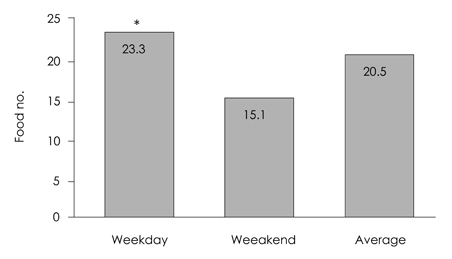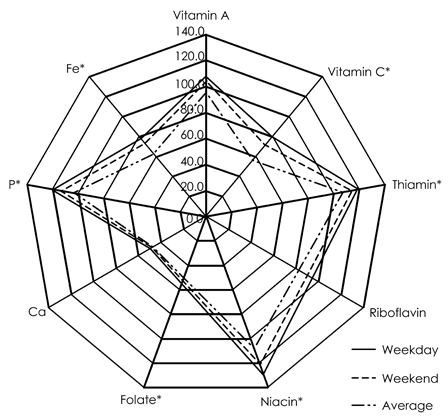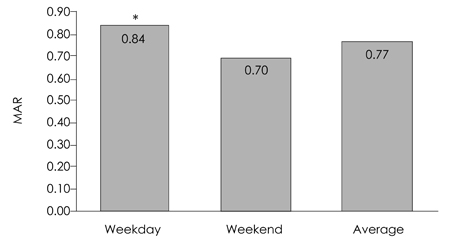Korean J Nutr.
2010 Oct;43(5):513-523. 10.4163/kjn.2010.43.5.513.
The Food and Nutrient Intakes on weekdays and weekends Among High School Girls in Seoul
- Affiliations
-
- 1Department of Food Service Management and Nutrition, Sangmyung University, Seoul 110-743, Korea. hhong2009@hanmail.net
- KMID: 2268048
- DOI: http://doi.org/10.4163/kjn.2010.43.5.513
Abstract
- The food and nutrient intakes on weekdays and weekends was examined with 196 high school girls residing in Seoul using the 3-day food record. Frequency for skipping breakfast was higher than that for lunch and dinner. Frequencies for skipping breakfast and lunch were significantly higher on weekends than on weekdays (p < 0.05). The daily average food, vegetable food, and animal food intakes were 1,074.8 g, 680.0 g, and 317.3 g, respectively. The total food and vegetable food intakes on weekdays were significantly higher than on weekends (p < 0.05). The daily average dietary variety score (DVS) was 20.5, and was significantly higher on weekdays (23.3) than on weekends (15.1)(p < 0.05). The daily averages of energy, protein, fat and carbohydrate intake were 1,732.9 kcal, 68 g, 56.2 g, and 240.9 g, respectively. Energy, protein, carbohydrate, phosphate, iron, sodium, potassium, thiamin, niacin, folate and vitamin C intakes were significantly higher on weekdays than on weekends (p < 0.05). Fat intake was significantly lower on weekdays than on weekends (p < 0.05). The daily average percentages of energy intake from carbohydrate, protein, and fat were 55.4%, 15.6%, and 29.0%: 56.1%, 15.8%, and 28.2% on weekdays and 54.7%, 15.3%, and 30.1% on weekends, respectively. The percentages of energy intake from carbohydrate on weekdays and weekends were below 60%, and that from fat was above 28% on weekdays and weekends. The daily averages of energy, vitamin A, riboflavin, niacin and phosphate intake were above 80% as compared with the estimated energy requirement (EER) or the recommended intake (RI). The intakes of calcium, potassium and folate were below 50% as compared with the adequate intake (AI) or (RI). The daily average mean adequacy ratio (MAR), an index of overall dietary quality, was 0.77, and significantly high school girls was worse on weekends than on weekdays.
Keyword
MeSH Terms
Figure
Cited by 1 articles
-
Comparison of food and nutrient intake between weekday and weekend for elementary and middle school students by gender in Busan and some parts of Kyungsangnamdo
Mi Jeong Kim
J Nutr Health. 2013;46(4):332-345. doi: 10.4163/jnh.2013.46.4.332.
Reference
-
1. Lee JW, Lee MS, Kim JH, Son SM, Lee BS. Nutritional assessment. 2008. Kyunggi: Kyomun Publishing Co..2. Cosper BA, Wakefield LH. Food choices woman. Personal, attitude, and motivational factors. J Am Diet Assoc. 1975. 66:152–115.3. Kim EK, Nam HW, Park YS, Myung CO, Lee KW. Nutrition across the life span. 2008. Seoul: Shinkwang Publishing Co..4. Ministry of Health and Welfare & Korea Center for Disease Control and Prevention. 2007 National health and nutrition examination survey report. 2008. Seoul:5. Choi MJ, Yun SJ. The interest of female high school students for weight control and nutrient intake status in the Daegu area. J East Asian Soc Diet Life. 2007. 17:329–337.6. Kim BR, Kim YM. A study on the food habits and the evaluation of nutrient intakes of high school students in Chuncheon. J Korean Home Econ Educ Assoc. 2005. 17:35–52.7. Chai HJ, Hong H, Kim HS, Lee JS, Yu CH. A study on food and nutrient intakes of weekday and weekend among high school boys in Seoul. Korean J Nutr. 2008. 41:539–549.8. Kim CS, Hong H, Kim JY, Maeng WJ, Lee JS. A study on nutrient intake status and food sources of iron by dietary iron density of high school girls in Seoul. Korean J Nutr. 2007. 40:371–384.9. The Korean Nutrition Society. Can Pro 3.0 (nutritional analysis program). 2006.10. The Korean Nutrition Society. Dietary Reference Intakes for Koreans. 2006. Seoul:11. Kim YO, Suh I, Nam CM, Kim SI, Park IS, Ahn HS. Macronutrient intake and blood pressure of adolescents in rural Korea. Korean J Community Nutr. 1996. 1:366–375.12. Lee RD, Nieman DC. Nutritional assessment. 2007. 4th ed. New York: McGraw-Hill.14. Kang JH. Evaluation criteria of health body weight in Koreans-Focus on obesity. Korean J Community Nutr. 2001. 6:397–401.15. Park SJ, Park YJ. A study on concern about weight control, nutrition knowledge, eating behavior and nutrients intake according to weight control attempt among high school girls in Seoul. J East Asian Soc Diet Life. 2001. 11:356–367.16. Lee EJ, Soh HK, Choi BS. Problems analysis related to nutrition and the development of nutrition education programs for high school students (I). J East Asian Soc Diet Life. 2007. 17:338–350.17. Yi BS, Yang IS. An exploratory study for identifying factors related to breakfast in elementary, middle and high school students. Korean J Community Nutr. 2006. 11:25–38.18. Cho SH, Yu HH. Nutrition knowledge, dietary attitudes, dietary habits and awareness of food-nutrition labelling by girl's high school. Korean J Community Nutr. 2007. 12:519–533.19. Kim BR, Kim YM. Evaluation of food intake and diet quality in high school students. J Korean Home Econ Educ Assoc. 2005. 17:83–96.20. Shim JE, Park HY, Moon HK, Kim YO. Comparative analysis and evaluation of dietary intakes of Koreans by age groups: (2) food and food group intakes. Korean J Nutr. 2001. 34:568–579.21. Park MY, Park EJ, Chung YJ. Evaluation of diet quality of Korean adolescents based on nutrient and food and food group intake. Chungnam J Home Economics. 2005. 18:95–110.22. Jung IK. A study on the nutrient intakes and factors related to dietary behavior of women by age groups in Incheon. Korean J Community Nutr. 2005. 10:46–58.23. Lee JS, Yun JW. A study on perception about body image, dietary attitude, dietary self-efficacy and nutrient intake of high school students in Busan. J Korean Soc Food Sci Nutr. 2003. 32:295–301.
Article24. An GS, Shin DS. A comparison of the food and nutrient intake of adolescents between urban areas and islands in South Kyungnam. Korean J Community Nutr. 2001. 6:271–281.25. Song YJ, Joung HJ, Kim YN, Paik HY. The physical development and dietary intake for Korean children and adolescents: Food and nutrient intake. Korean J Nutr. 2006. 39:50–57.26. Cho JW. Analysis of regional dietary intake of adolescents in Korea [Master's thesis]. 2002. Seoul: Seoul National University.27. Park ES, Lee YS, Joo EJ. Effects of nutrition knowledge and food habits on nutrient intake in high school girl students. J East Asian Soc Diet Life. 1996. 6:167–176.28. Lee MS, Sung CJ, Sung MK, Choi MK, Lee YS, Cho KO. A comparative study on food habits and nutrient intakes among high school students with different obesity indexes residing in Seoul and Kyunggi-do. Korean J Community Nutr. 2000. 5:141–151.29. Kim MH, Sung CJ. The study of relationship among serum leptin, nutritional status, serum glucose and lipids of middle-school girls. Korean J Nutr. 2000. 33:49–58.
- Full Text Links
- Actions
-
Cited
- CITED
-
- Close
- Share
- Similar articles
-
- A Study on Nutrient Intake Status and Food Sources of Iron by Dietary Iron Density of High School Girls in Seoul
- The Relationship between Food and Nutrient Intakes, Glycemic Index, Glycemic Load, and Body Mass Index among High School Girls in Seoul
- Effects of Weekend on the Prognoses for Patients Visiting to Emergency Medical Centers
- The Analysis of the Difference between Interviewers and the Days of the Week using the 24-Hour Dietary Recall Method
- Association between sleep duration, sleep quality, time use and dietary quality of high school students in Chungnam




